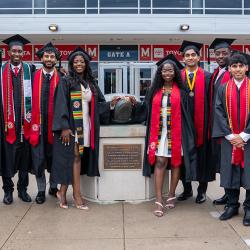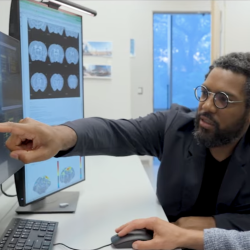Daniel Butts' Work Using Artificial Neural Networks to Understand the Visual System Featured in Press Conference at Neuroscience 2023
Using machine learning, researchers glean deeper insights from brain data and apply this new knowledge in clinical settings. A research team led by University of Maryland neuroscientists used artificial neural networks to uncover how cells in the visual cortex interpret light signals from the retina and translate that data into vision.
“Using machine learning, we are beginning to understand how information about the visual world is carried across brain cells in the visual cortex,” said the study’s senior author Daniel Butts, an associate professor of biology at UMD.
The findings were presented at a press conference in Washington, D.C., on November 13, 2023, at Neuroscience 2023, the annual meeting of the Society for Neuroscience (SfN) and the world’s largest source of emerging news about brain science and health. SfN is an organization of nearly 35,000 basic scientists and clinicians who study the brain and the nervous system.
The team, which also included researchers from the National Institutes of Health and UC Berkeley, used a novel application of artificial neural networks to learn how cells in the visual cortex of the brain interpret light signals captured by the retina.
When light hits the retina in the back of the eye, the light rays are transformed into electrical impulses and sent to the visual cortex in the back of the brain. There, a massive number of neurons converts these signals into images and visual perceptions.
“Our understanding of how these computations are implemented by visual circuits is limited by our ability to model the complex nonlinearities present in the system,” Butts said. “Our approach using a biologically constrained convolutional deep neural network provides a new foundation to understand how visual processing is implemented by neurons in the visual cortex.”
In addition to Butts, UMD co-authors of the study included neuroscience and cognitive science Ph.D. students Matthew Jacobsen and Felix Bartsch.
“Advances in AI and machine learning are transforming brain research and clinical treatments,” said Terry Sejnowski, the Francis Crick Professor at the Salk Institute for Biological Studies and distinguished professor at UC San Diego, who moderated the press conference. “Brain recordings produce huge datasets that can be analyzed with machine learning. Predictive modeling, machine-brain interfaces, and neuroimaging/neuromodulation are areas with particular promise in developing new therapeutics and treatment plans for patients.”
Adapted from article provided by the Society for Neuroscience.







